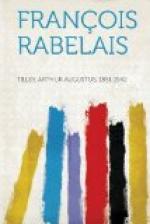|
This section contains 12,878 words (approx. 43 pages at 300 words per page) |

|
SOURCE: “Gargantua: Inheriting the Father,” in Father Figures: Genealogy and Narrative Structure in Rabelais, Cornell University Press, 1991, pp. 52-89.
In the following excerpt, Freccero argues that unlike Pantagruel—whose defining metaphor is that of the text as organic growth—Gargantua presents itself as an artificial construct.
Whereas during the earlier phases of humanism the metaphor of rebirth conserved a relatively simple relationship with its “reality reference,” the Rabelaisian text explicitly complicates the connection.1 The organic trope of rebirth or even exhumation and resuscitation that continues to make its appearance in Pantagruel (on the level of subject matter as well) gives way to archaeological and architectural metaphors of excavation and reconstruction in Gargantua, where a self-consciousness of the text as written discourse dominates. This is in part a political gesture, a polemic against the pretentious genealogies constructed in the sixteenth century to justify national chauvinism, as Walter Stephens has...
|
This section contains 12,878 words (approx. 43 pages at 300 words per page) |

|


